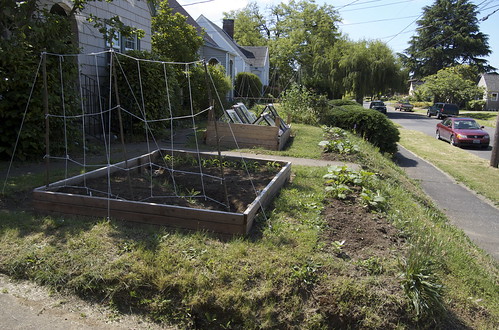Posts Tagged ‘Homestead’
Suburban Homesteading – One, Two, Three
Three Easy Steps To Get You Started – Homesteading In Suburbia
Part One of a Three Part Series
Starting a suburban homestead can be a daunting task, not to mention gleaning through the mounds of information and trying to scale it down to meet the needs of your suburban homestead. With this in mind, Suburban Homesteading – One, Two, Three will lay out the basic steps for turning your suburban home into a productive homestead.
During the homesteading era of the 1800’s, a family’s primary concerns were to provide shelter, warmth, food and water. But for the modern day suburban homesteader, these are either already provided through the home (i.e. heat and water) or easily accessible as in the case of food from a grocery or big-box store. So, homesteading becomes a choice rather than a necessity. Even though you have time to think about what you want to do as a suburban homesteader, there are still practical steps each family should take. And the first step to take is to PLAN.
STEP ONE – Having the Family Discussion
If you’ve been thinking about turning your humble suburban lot into a thriving, productive “mini-farm,” discuss it with your family first…kids included. It’s difficult to homestead alone, and without the family’s “buy-in,” it can be an uphill struggle.
Talk about the kind of homestead you want to have and how self-sufficient you want to become.
The most important step in a successful homestead that doesn’t overwhelm you is “THE PLAN”. Since this is the beginning stage of the plan, dream big and list everything you want to do, be and have. Don’t worry about having enough space or buying the right supplies, there are plenty of people who grow food on apartment balconies or on condo patios.
Reality will set in soon enough – forcing you to scale down your plans and be a bit more realistic. But, for now, the sky’s the limit.
To help get you talking about the possibilities a sampling of questions you and your family will want talk about is below. As you go through this process, more questions may come to mind. Include any of your own questions along with the answers to the list that is provided. This is by no means all the questions that should be asked. They’re provided just to get you thinking.
The answers to some of these questions will depend on the amount of time and effort you want to dedicate, and can dedicate to your homesteading venture.
Be sure to write down your answers so you’ll have them for future steps in the process. Read the rest of the story »
Tip For The Week
Water conservation is a top priority on any homestead.
One way to help save all you can is to keep a plastic pitcher near the sink. Use it to collect ice cubes, leftover water in glasses, water from cooking pasta, potatoes, hard boiled eggs, etc. You’ll be amazed at how much accumulates throughout the day.
Once the pitcher is full the water can be used for potted plants or in the garden – saving what is needed from the tap.
Taking Control Of Your Life
If you’ve decided to take control of your life in these uncertain economic times, you’re not alone.
Thousands of families are taking control of their lives by turning their “home” into a “homestead”. And, in doing so, they’ve found a level of personal security in being less vulnerable.
Economic survivalists take root
When the economy started to squeeze the Wojtowicz family, they gave up vacation cruises, restaurant meals, new clothes and high-tech toys to become 21st-century homesteaders.
Now Patrick Wojtowicz, 36, his wife Melissa, 37, and daughter Gabrielle, 15, raise pigs and chickens for food on 40 acres near Alma, Mich. They’re planning a garden and installing a wood furnace. They disconnected the satellite TV and radio, ditched their dishwasher and a big truck and started buying clothes at resale shops.
“As long as we can keep decreasing our bills, we can keep making less money,” Patrick says. “We’re not saying this is right for everybody, but it’s right for us.”
Hard times are creating economic survivalists such as the Wojtowicz family who are paring expenses by becoming more self-sufficient.
Read more about one family’s venture into a more self-sufficient lifestyle.
Food Storage Fundamentals
 One of the goals of any homestead is to ultimately provide homegrown fruits, vegetables, meat and dairy. And a “suburban homestead” is no different. But, we all have to eat while the homestead “gets off the ground”. Along with that, we should always be prepared to survive what ever natural disasters frequent the area of the country we live in. One way to do this is with long-term food storage.
One of the goals of any homestead is to ultimately provide homegrown fruits, vegetables, meat and dairy. And a “suburban homestead” is no different. But, we all have to eat while the homestead “gets off the ground”. Along with that, we should always be prepared to survive what ever natural disasters frequent the area of the country we live in. One way to do this is with long-term food storage.
Now, more than ever, the topic of food storage is being discussed from coffee houses to corner offices. The more information we hear about the depth of our economic challenges, the length of time it will take to fully recover and the predictions about food shortages, the more families are turning to storing food.
With all the information swirling around the actual process of figuring out what to store, how much to store, where to store it and what to store it in can be quite daunting.
The websites below give great information about the entire process.
The University of Utah website gives a concise easy to understand overview of the need and process of food storage; while the food calculator you’ll find here is a great tool to figure out “how much” of each food item your family should store.
Food Storage Made Easy is a fun website that can address all your questions about food storage. It also has a lot of great examples and photos of what a food storage pantry looks like.
I haven’t mentioned food storage containers mainly because I prefer the more frugal approach of getting food grade buckets from donut shops or deli. If that’s not your style, you can Google food storage containers, there are lots of choices.
The best way to make it through any disaster, whether natural or man-made is to be prepared. But, remember this is a process that can be done over time; adding storage items to your weekly or monthly shopping. Or, whenever you find great sales on the foods your family enjoys. It doesn’t have to be done all at once.


Recent comments
Aenean nonummy hendrerit mauris. Phasellus porta.